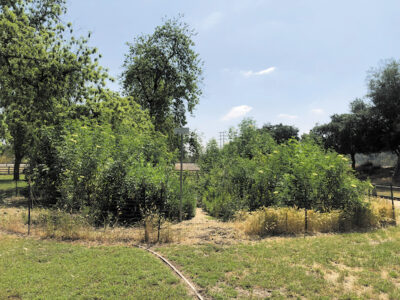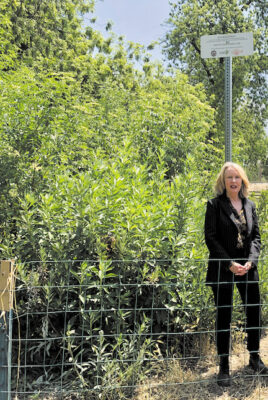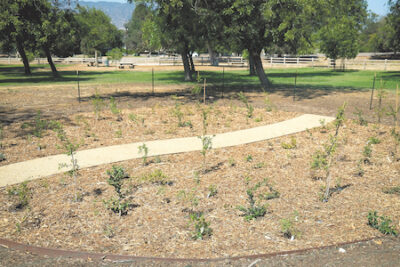Micro-forest’s macro accomplishments in Griffith Park
In a little corner of Griffith Park, known as the Bette Davis picnic area, a bushy green micro-forest teems with life. This 1,000-square-foot circular forest has grown from tiny seedlings planted June 19, 2021, to

a towering 18- to 20-foot canopy only two years later, and fauna have noticed. The coast live oaks, hollyleaf redberries, toyons, California wild roses and other native species are home to burrowing squirrels, Western toads, lizards, lots of insects and myriad birds.

BUSHY green micro-forest teems with flora and fauna.
“Birders have discovered the forest,” says Los Angeles Parks Foundation Nursery Manager Cameron De Anda, who oversees maintenance of the new forest. “They come here all the time to observe the birds.”
The project was born when Carolyn Ramsay, executive director of the Los Angeles Parks Foundation, heard about a method of planting that encourages rapid growth, pioneered by Japanese botanist Akira Miyawaki in various sites in Asia and parts of Europe. Using only indigenous seeds and dense heterogenous planting groups, this novel method allowed small spaces to quickly achieve macro results in terms of absorbing carbon dioxide from the atmosphere, releasing oxygen in exchange and increasing the biodiversity of an area. Especially important in cement-centric urban areas, these Miyawaki-method forests can fit in backyards and pocket parks to clean the air and lower temperatures. Micro-forests typically achieve self-sustainability within two to three years.
Ramsay wanted to try it in the Mediterranean climate of Los Angeles.
Hancock Park Garden Club
Concurrently, the Hancock Park Garden Club had decided to help increase the green canopy in Los Angeles not just in our neighborhood, but city-wide. Club members joined forces with the Parks Foundation to pilot the micro-forest plan, providing a $15,000 grant to cover planting and maintenance of the Miyawaki-method forest. Seeds from existing plants in Griffith Park were collected and grown and supplemented with purchased indigenous seedlings. Volunteers did the planting. De Anda oversees watering, weeding and any other work needed.

EXECUTIVE DIRECTOR of the Los Angeles Parks Foundation, Carolyn Ramsay, kickstarted the project.

FOREST at the time of June 2021 planting.
“Because of the rains, we only watered two times recently,” notes De Anda, continuing, “I believe that the forest can self-sustain if we were to stop watering. The rainfall we got at the beginning of this year really helped out a lot in getting water deeper into the ground so our native plants can reach deep down with those taproots and survive the dry summer.” In the fall, he would like to plant more undergrowth and muskweed to attract butterflies. He continues, “We have lost quite a few plants. It’s the survival of the fittest.”
De Anda explains that the smaller plants that die fertilize the growth of other stronger plants. Also part of the natural process is that nearby park plants encroach on the planned forest, and birds drop seeds from other parts of the park. Those indigenous plants then form part of the ecosystem.
Now that it is proven that a Miyawaki forest can flourish in a Mediterranean climate, Ramsay reports that the Los Angeles Parks Foundation would like to plant more micro-forests. De Anda is already gathering seeds and taking cuttings from this forest to begin another one. They just need money and a site.
The Miyawaki forest is surrounded by a wire fence for protection, but those who would like to walk the 40-foot path through the forest should contact the Parks Foundation at info@LAParksFoundation.org or call 310-472-1990.
The one-year update appeared in the June 2022 issue.
Category: Real Estate
